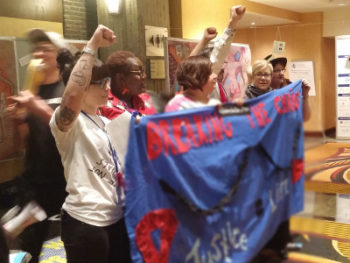Not many things can make the anxiety levels of a meeting planner rise more than a protest.
Here are a few tips from my experience to help make the best of a potentially bad situation.
With the rise of social media and participant engagement on various platforms, the rumors of a protest come to us more easily – as long as we are looking. Ensure you have a staff member, planning committee member, or marketing specialist monitoring all event-related social media platforms for conversations about a group gathering with negative connotations at or near your venue. This is especially important if you have an ‘unpopular’ politician or controversial presenter or any speaker or session that has a history of controversy or debate.
At a recent conference in Montreal this past spring we identified a Facebook group with the sole purpose of enlisting followers to join in a protest movement at our client’s event. Luckily for us, the Facebook group identified the time, place and purpose and the movement and we were even able to get a sense of the participants – some of whom were conference registrants. With a few hours’ notice we were able to put a plan in place.
One of the most important first steps is to identify the level of aggression of the protester or group. The venue should be notified right away and security put on alert. Keep the venue up to date with all the details, including where and when. They may be able to bring in extra security if necessary. You also need to determine if the police should be called in or at least made aware of the situation. If you have reason to believe the protest may evolve into violence, certainly inform the local police detachment right away.
Another important step is to identify the purpose of the protest – what is the message they are trying to get across and does it align with your audience? Is the target a particular person or company, or perhaps they are opposing a policy or a piece of government legislation? If the target is a person or group of people at your event, ensuring adequate security should be your first priority.. Double up on your door monitors to ensure no one gets through without an official name badge. If the protester or group sneaks in without a badge it can look really bad for the event organization.
If the primary focus of the protest is simply to be heard, consider the option of giving them a platform. If feasible, offer the group an unused meeting room (equipped with a stage and microphone) for 30 minutes. Perhaps send out a tweet or an app push notification announcing the impromptu event. By giving them the time and space, and an audience, you may be able to diffuse a potentially volatile situation.
At a recent event Sea to Sky managed, after conferring with the client, lunch sponsor and speakers, it was decided to offer the protest group the plenary room stage for the first part of the lunch hour. Lunch was put on hold while the group took over the mic and their voices were heard loud and clear. We learnt later the participants actually appreciated hearing from the protesters, who just wanted to suggest a greater sense of urgency and gather support for their particular issue. In the end, the protesters were satisfied: their message was heard, the distraction was kept to a minimum and the group left peacefully after about 30 minutes.
It goes without saying that the best outcome of a protest is always a peaceful one. It’s also true that the more notice you receive that trouble is on the way, the easier it will be for you to manage the situation.
Kazia Ekelund, BTM, DRHM
Project Manger




